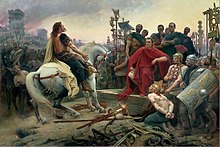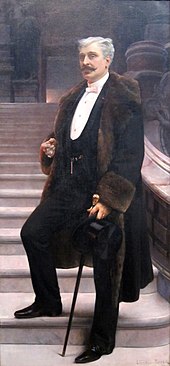Lionel Royer
This article needs additional citations for verification. (October 2010) |


Lionel-Noël Royer (25 December 1852 – 30 June 1926) was a French painter. He was most famous for painting large scenes of the life of Joan of Arc in the Basilica of Bois-Chenu in Domrémy.
Life and work
Lionel Royer was born in
Royer became a pupil of

In memory of his participation in the battle of Loigny, he donated two paintings to the rebuilt church of this village, the first representing the mass attended by the volunteers before leaving for the battle and the second depicting the nocturnal agony of the severely wounded
"The battle scenes at Orléans before the fortress or at Compiègne offer Royer, the painter of historical scenes, an opportunity to demonstrate his skill in composition, with the tangle of armour-clad bodies and the play of lances. To elicit emotion, both allegory and the marvellous come to the aid of history. [...] Lionel Royer relies heavily on the precise depiction of historical sites. [...] Joan, alone in the foreground, is the means by which a possible reconciliation between the political and religious spheres is suggested. [...] By the evocative synthesis he achieves and the deep feeling he introduces here, the painter leaves interpretation open to each observer." (Chantal Bouchon - Revue Historique et Archéologique du Maine)
Royer reprised this Johannic iconography (assisted by
"Despite indications of the influence of the figures by
Ingresesquereminiscences, these windows have a connotation of appeals to vengeance, in the vicinity of Domrémy, so charged with symbolic significance." (Chantal Bouchon - Revue Historique et Archéologique du Maine)
Royer had two daughters and a son. The son, who planned to become a priest, was injured in World War I and died shortly after. The two girls raised families in France and Belgium. Lionel Royer died in Neuilly-sur-Seine on 30 June 1926.

Bibliography
- "Peindre l’Histoire – Lionel Royer" in Revue Historique et Archéologique du Maine, Le Mans, 1998 (including 10 scenes from Vie de Jeanne d’Arc by Lionel Royer: ).
- Chantal Bouchon, "Verrières de Jeanne d'Arc – Participation des artistes manceaux aux Concours d'Orléans à la fin du XIXe siècle: Eugène Hucher, Albert Maignan, Lionel Royer", in Revue Historique et Archéologique du Maine, Le Mans, 1998, 3e série T.18, tome CXLIX de la Collection, p. 241-256
References
- Biography of Royer (South Coast Fine Art - 3 Oct 2010)
- Jean- François Luneau Felix Gaudin - peintre verrier et mosaïste, Presse Universitaire Blaise Pascal, Clermont Ferrand, 2006, p 406-407
External links
- Portraits of the marquis and marquise de Broc (Christie's)
- A girl and her doll (South Coast Fine Art - 3 Oct 2010)
